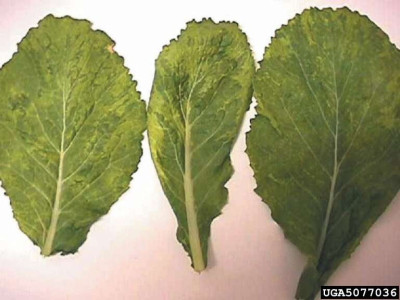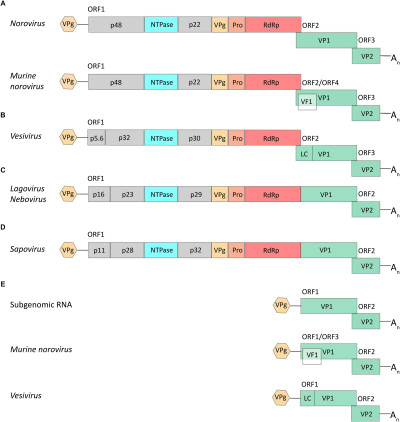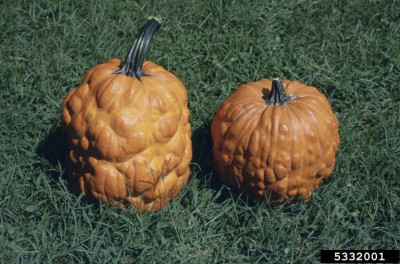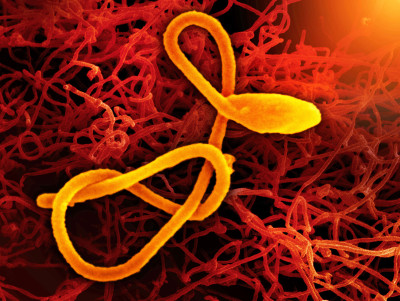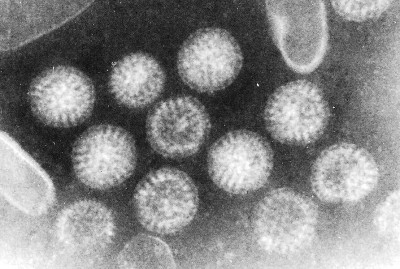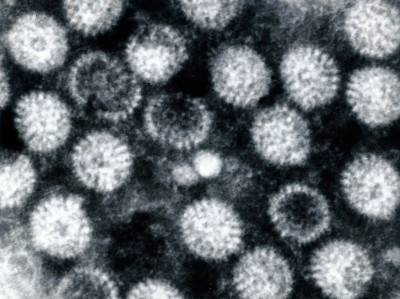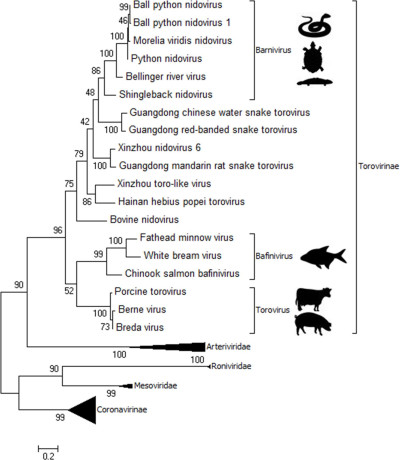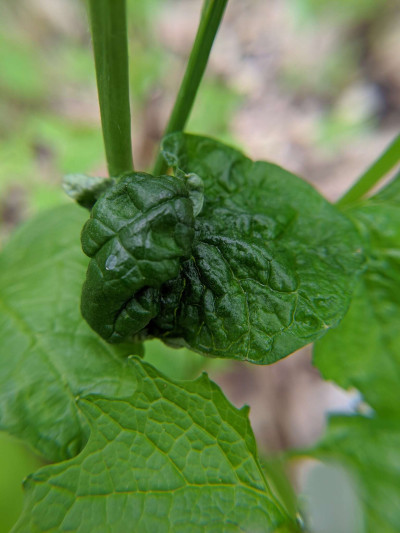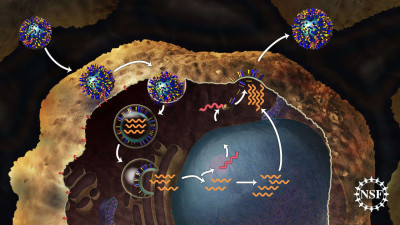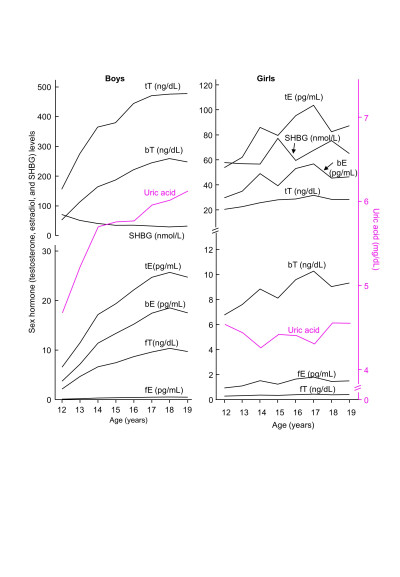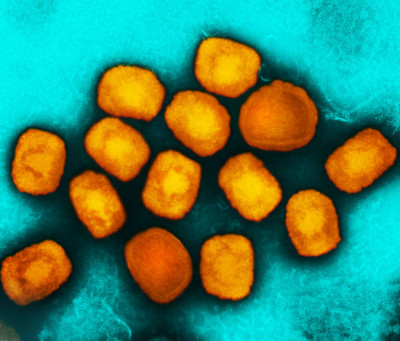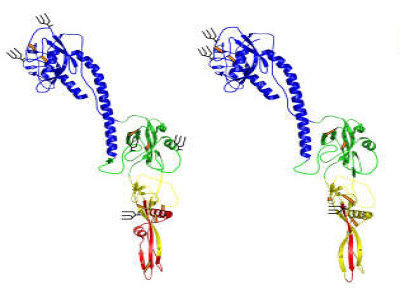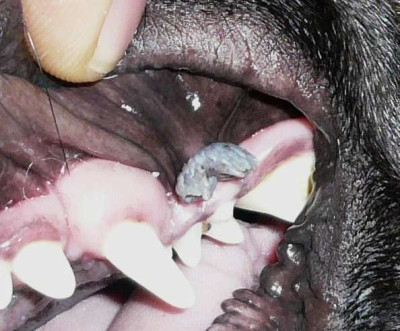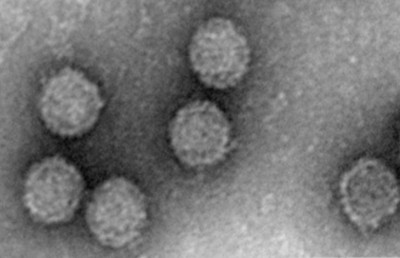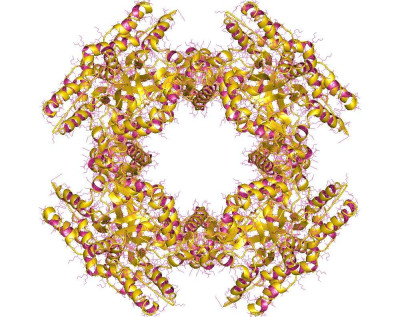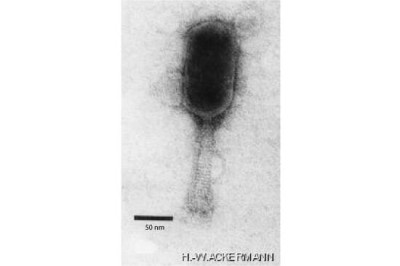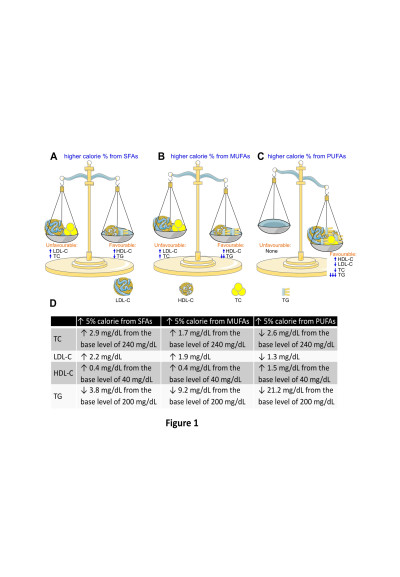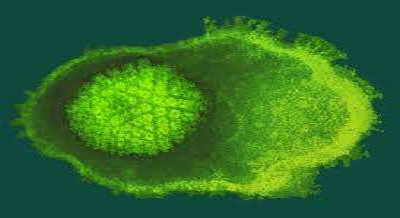Leaves showing interveinal chlorosis, puckering and distortion.
David B. Langston, University of Georgia, Bugwood.org
02 Apr 2024
Schematic representations of typical calicivirus genome organizations. (A–D) Genomic full-length RNAs of about 7.5 kb in size contain either two ORFs (in viruses of the genera Lagovirus, Nebovirus, and Sapovirus) or three ORFs (Norovirus and Vesivirus), except for the genomic RNA of Murine norovirus (MNV; genus Norovirus) that may contain an additional ORF (encoding the VF1 protein). (E) All caliciviruses except MNV and vesiviruses have subgenomic RNAs of about 2.1 kb in size with two ORFs that encode the main structural proteins, VP1 and VP2; the subgenomic RNA of MNV includes three ORFs (similar to the corresponding genomic RNA) and the subgenomic RNA of vesiviruses encodes – apart from proteins VP1 and VP2 – a small leader of the capsid protein (LC). Colored boxes represent coding sequences that are flanked by untranslated leader and trailer sequences (shown as lines). Hexagons represent VPg proteins that are covalently bound to the 5′ end of all genomic and subgenomic RNAs; An represents the poly(A) tail at the 3′ end of all genomic and subgenomic RNAs. [1]
Wikimedia Commons, Elena Smertina, Nadya Urakova, Tanja Strive, and Michael Frese
02 Apr 2024
Symptoms of Papaya Ringspot Virus (Potyvirus PRSV).
Wikimedia Commons, Mary Ann Hansen
02 Apr 2024
Creative artwork featuring a scanning electron micrograph of a single filamentous Ebola virus particle (colorized yellow and orange) in the foreground, and a second scanning electron micrograph of filamentous Ebola virus particles (red) budding from a chronically infected VERO E6 cells in the background. Both images, which have been colorized in Halloween-appropriate colors, were captured at the NIAID Integrated Research Facility in Ft. Detrick, Maryland.
Wikimedia Commons, NIAID
03 Apr 2024
Transmission electron micrograph of rotavirus.
Wikimedia Commons, Graham Beards
18 Apr 2024
Electron micrograph of rotaviruses, negatively stained by potassium phosphotungstate. Magnification approximately x 400,000.
Wikimedia Commons, Graham Beards
18 Apr 2024
Phylogenetic tree showing the genetic relationships of members of the sub-family Torovirinae based on the conserved RdRp site of polyprotein 1b. Representative strains of the order Nidovirales are also included. The comparison was based on the alignment of 268 amino acid positions within the conserved RNA-dependent RNA polymerase (RdRp) region of polyprotein 1b. Phylogenetic tree was inferred with 1000 bootstrap replicates using the Maximum Likelihood method based on the JTT matrix-based model [1]. Branch lengths are in scale to the scale bar. The percentage bootstrap value associated with each lineage is indicated. The viruses included were ball python nidovirus [AIJ50565.1]; ball python nidovirus 1 [KM267236]; Morelia viridis nidovirus [ASO76150.1]; python nidovirus [AII00825.1]; Bellinger river virus [MF685025]; Shingleback nidovirus [AOZ57153.1]; Xinzhou nematode virus 6 [APG77345.1]; Xinzhou toro-like virus [YP 009344970.1]; Hainan hebius popei torovirus [MG600028]; Guangdong chinese water snake torovirus [MG600029]; Guangdong red-banded snake torovirus [MG600030]; Guangdong mandarin rat snake torovirus [MG600031]; Bovine nidovirus [YP 009142787]; Fathead minnow nidovirus [ADN95978.2]; White bream virus [YP 803213]; Chinook salmon bafinivirus [AVM87336.1]; Porcine torovirus [NC 022787.1]; Berne virus [P0C6V7.1]; Breda virus [YP 337905.2]; members of Arteriviridae, Mesoniviridae, Roniviridae, Coronaviridae are provided, along with aligned amino acid residues. [2]
Wikimedia Commons, Jing Zhang, Deborah S. Finlaison, Melinda J. Frost, Sarah Gestier, Xingnian Gu, Jane Hall, Cheryl Jenkins, Kate Parrish, Andrew J. Read, Mukesh Srivastava, Karrie Rose, Peter D. Kirkland
25 Apr 2024
Turnip crinkle virus (TCV) is a plant virus that primarily affects members of the Brassicaceae family, including turnips, mustard greens, and other cruciferous vegetables. It belongs to the genus Carmovirus within the family Tombusviridae. TCV is known for causing crinkling and distortion of leaves, stunting, and reduced yields in infected plants.
iNaturalist
11 May 2024
In order to infect a healthy cell, a flu virus must enter the cell (upper left) and empty viral genes into it. First, the virus binds to the cell. Then it becomes enveloped inside a bubble called an endosome as it gets taken into the cell. It is acidic inside the endosome--more acidic than the interior of the virus it contains. This pH difference serves as a signal to the virus that it is inside the cell, so it is time to release the viral genes (shown as orange squiggles). It is the M2 proton channel that helps the virus sense this difference in acidity and trigger the release of viral genes into the cell. Since the cell cannot tell the difference between its own genes and those of the virus, it gets tricked into making copies of the virus which can eventually go on to infect other cells.
Nicolle Rager Fuller, National Science Foundation
25 Jan 2024
Serum levels of sex hormones and uric acid in adolescents aged 12-19 years. Left panel, 1 042 boys which represented a weighted sample size of 13 448 725. Right panel, 993 girls which represented a weighted sample size of 12 291 504. bE, bioavailable estradiol; bT, bioavailable testosterone; fE, free estradiol; fT, free testosterone; SHBG, sex hormone-binding globulin; tE, total estradiol; tT, total testosterone. Data represent the weighted mean values over each year of age. [1]
05 Mar 2024
Colorized transmission electron micrograph of monkeypox virus particles (orange) cultivated and purified from cell culture. Image captured at the NIAID Integrated Research Facility (IRF) in Fort Detrick, Maryland.
Wikimedia Commons
08 Apr 2024
Models of THOV GP (left) and AcMNPV GP64 (right) based on the X-ray crystallographic structure of VSV G. Key: blue: domain III; green: domain I; yellow: domain II; red: fusion loops; orange/black lines: dicysteine linkages; black lines: N-glycosylation sites.
Wikimedia Commons, Courtney E Garry and Robert F Garry
01 Apr 2024
Viral papilloma in a young Pug, on the buccal mucosa.
Wikimedia Commons, Joelmills
24 Jan 2024
Purified viral particles of BAV HB14-71-01 were observed under an electron microscope (EM).
Wikimedia Commons, Han Xia, Hong Liu, Lu Zhao, Evans Atoni, Yujuan Wang, and Zhiming Yuan
24 Jan 2024
The DNA breaking and joining reactions mediating integration. Gray ovals represent integrase monomers, thick red lines represent viral DNA, black lines represent target DNA, and dots represent 5′ ends. (1) Linear blunt-ended viral cDNA is bound by integrase as part of the preintegration complex. (2) Integrase removes two nucleotides from the 3′ ends of the viral DNA, exposing recessed 3′ hydroxyl groups. (3) IN joins the recessed 3′ ends of viral DNA to the target DNA. (4) Unpairing of the target DNA between the joined ends of the viral DNA yields gaps in the target DNA. (5) DNA repair enzymes fill in the gaps. (6) The provirus is flanked by repeated segments of the target DNA.[1]
Mary K. Lewinski, Masahiro Yamashita, Michael Emerman, Angela Ciuffi, Heather Marshall, Gregory Crawford, Francis Collins, Paul Shinn, Jeremy Leipzig, Sridhar Hannenhalli, Charles C. Berry, Joseph R. Ecker, Frederic D. Bushman, Wikimedia Commons
08 Feb 2024
NSP2 (NonStructural Protein 2) oktamer, Human rotavirus.
Jiang, X., Prasad, B.V.V., Astrojan, Wikimedia Commons
08 Feb 2024
Maximum likelihood phylogenetic tree of the amino acid sequences of the RNA-dependent RNA polymerase (RdRp). The virus families are color-coded and the hosts for viruses within each group are indicated in the outermost circle. The six groups are identified in the legend and the boundaries of these groups are indicated in the outer ring of the phylogeny. Group I: Peribunyaviridae, Phenuiviridae, and Cruliviridae. Group II: Fimoviridae and Tospoviridae. Group III: Hantaviridae and Phasmaviridae. Group IV: Arenaviridae and Mypoviridae. Group V: Nairoviridae and Wupedeviridae. Group VI: Phenuiviridae, Leishbuviridae, and unassigned species. Clade validation is based on the approximate likelihood ratio test (aLRT)-Shimodaira–Hasegawa (SH)-like test values. [1]
Wikimedia Commons, Herath, V., Romay, G., Urrutia, C.D., Verchot, J
01 Mar 2024
Electron micrograph of a virion of species Schizotequatrovirus. Non-enveloped, head-tail structure. The prolate head is 140 nm in length and 70 nm in width. The tail is 140 nm in length, contractile, has 6 long terminal fibers, 6 short spikes and a small base plate.
ViralZone, SIB Swiss Institute of Bioinformatics, Wikimedia Commons
01 Mar 2024
A-B, Higher usual intake of saturated fatty acids (SFAs, A) and monounsaturated fatty acids (MUFAs, B) was associated with higher low-density lipoprotein cholesterol (LDL-C), higher total cholesterol (TC), higher high-density lipoprotein cholesterol (HDL-C) and lower triglyceride (TG). C, Higher usual intake of polyunsaturated fatty acids (PUFAs) was associated with higher HDL-C, lower LDL-C, lower TC, and lower TG. D, The extent of change in lipid profile associated with a 5% higher calorie intake from fatty acids. This figure was partly generated using Servier Medical Art, provided by Servier, licensed under a Creative Commons Attribution 3.0 unported license. [1]
04 Mar 2024
 Encyclopedia
Encyclopedia
